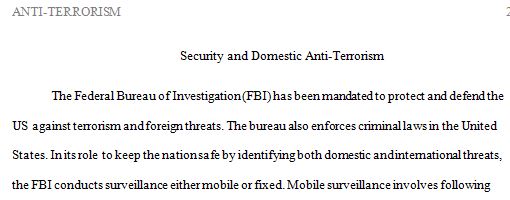
What are the limits of power of the FBI in pursuing surveillance of potential terrorists within and without the U.S.?
What are the limits of power of the FBI in pursuing surveillance of potential terrorists within and without the U.S.?
Module 3 – Case
SECURITY AND DOMESTIC ANTI-TERRORISM
Assignment Overview
The first two modules were concerned with the domestic terrorist and terrorist groups. This module begins the background preparation on the agencies tasked with preventing terrorists from being successful.
Case Assignment
1.What are the limits of power of the FBI in pursuing surveillance of potential terrorists within and without the U.S.?
2.In your view, is the FBI adequately organized, staffed, and trained to perform the myriad of missions tasked?
3.How has the USA Patriot Act impacted America’s counterterrorism efforts post-9/11 in balance with protecting civil liberties?
4.Explain the Department of Homeland Security’s role in combating domestic terrorism. What sub agencies are involved? What are their missions?
5.In your opinion, what vulnerabilities would a terrorist see based on your answers to the above four questions?
The following items will be assessed in particular:
1.Your understanding of the organization, roles and missions of the FBI and Department of Homeland security.
2.Your ability to express the controversies associated with these agencies attempting to perform their missions, obstacles in achieving success, and the impact of the Patriot Act.
3.In-text references to the modular background readings (APA formatting recommended) and a reference page. Outside background reading sources encouraged and expected.
Assignment Expectations
Length: This Case Assignment should be at least 4-6 pages not counting the title page and references.
References: At least two or more references should be included from academic sources (e.g. peer-reviewed journal articles). Required readings are included. Quoted material should not exceed 10% of the total paper (since the focus of these assignments is critical thinking). Use your own words and build on the ideas of others. When material is copied verbatim from external sources, it MUST be enclosed in quotes. The references should be cited within the text and also listed at the end of the assignment in the References section (preferably in APA format).
Organization: Subheadings should be used to organize your paper according to question.
Grammar and Spelling: While no points are deducted for minor errors, assignments are expected to adhere to standard guidelines of grammar, spelling, punctuation, and sentence syntax. Points may be deducted if grammar and spelling impact clarity.
The following items will be assessed in particular:
Relevance: All content is connected to the question.
Precision: Specific question is addressed. Statements, facts, and statistics are specific and accurate.
Depth of discussion: Present and integrate points that lead to deeper issues.
Breadth: Multiple perspectives and references, multiple issues and factors considered.
Evidence: Points are well-supported with facts, statistics and references.
Logic: Presented discussion makes sense, conclusions are logically supported by premises, statements, or factual information.
Clarity: Writing is concise, understandable, and contains sufficient detail or examples.
Objectivity: Avoid use of first person and subjective bias.
______________________________
Module 3 – Background
SECURITY AND DOMESTIC ANTI-TERRORISM
Required Reading
Bjelopera, J. P. (2013, April 24). The Federal Bureau of Investigation and terrorism investigations. Congressional Research Service. Retrieved from http://fas.org/sgp/crs/
Department of Justice (n.d.). The USA PATRIOT Act: Preserving life and liberty. Retrieved from http://www.justice.gov/
National Response Framework (2019, October 28). FEMA. Retrieved from https://www.fema.gov/
Los Angeles Police Department’s Counter-Terrorism and Criminal Intelligence Bureau (n. d.). “Counter-Terrorism and Crime Fighting in Los Angeles.” LAPDBLOG. Retrieved from http://lapdblog.typepad.
Congressional Research Service (2016, April 13). Surveillance of foreigners outside the United States under Section 702 of the Foreign Intelligence Surveillance Act (FISA). Retrieved from https://crsreports.
McAdams, J. G. (2007), Foreign Intelligence Surveillance Act (FISA): An overview, Federal Law Enforcement Training Center [Online ]. Retrieved from https://www.fletc.gov/
Required Websites
Joint Regional Intelligence Center (JRIC): https://www.jric.org/?
State and Major Urban Area Fusion Centers, DHS: https://www.dhs.gov/
Optional Reading
Liu, E. C., & Doyle, C. (2015). Government collection of private information: Background and issues related to the USA PATRIOT Act Reauthorization in brief. CRS. Retrieved from https://fas.org/sgp/crs/
Morris, L.W. (2014). Three steps to safety: Developing procedures for active shooters. Journal of Business Continuity & Emergency Planning. 7(2), 238-244. Available in the Trident Online Library.
Requirements: Follow what is required from the instructions provided.
One thing, the professor teaches this course and he’s picky with my writing and he checks in detail my grammar, this is why I need assistance. if something comes up I will update you
Answer preview for the “What are the limits of power of the FBI in pursuing surveillance of potential terrorists within and without the U.S.?”essay………………………….

apa 1587 words